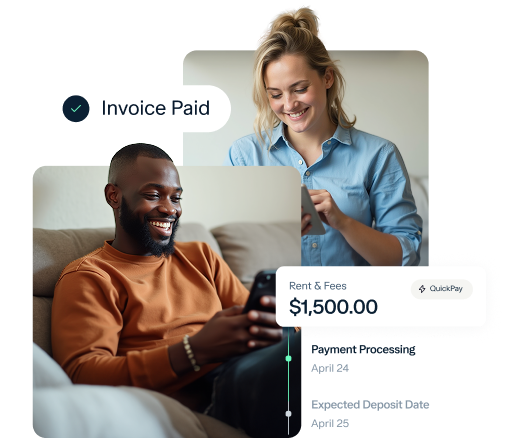Collecting rent on time is a critical factor in the success of your rental property business. However, balancing the need for consistent cash flow with tenants’ varied financial situations can be challenging. Traditional methods like checks are declining, with 81.7% of rent payments now made online as of Q1 2025, yet 39% of renters still use cash or checks, highlighting the need for modern solutions for both parties. Flexible rent collection is becoming a key strategy to address this gap, offering benefits for both landlords and tenants.
Key takeaways:
- Flexible rent collection methods offer alternatives to traditional monthly lump sums.
- These options can improve landlord cash flow and reduce late payments.
- Tenants benefit from payment flexibility.
- Various platforms and apps provide flexible rent payment solutions.
What is flexible rent collection?
Flexible rent collection refers to payment arrangements that deviate from the standard fixed monthly due date and amount. Instead of requiring the full rent payment on the first of the month, these options allow tenants more latitude in how and when they pay.
This approach acknowledges that many renters, especially the 48% who are cost-burdened, may face financial challenges or prefer payment schedules that match their pay cycles. Adopting flexible rent payment options can transform how you manage income from your properties.
Why landlords are adopting flexible options
Landlords are increasingly exploring flexible rent options to solve late payments and tenant retention issues. Offering flexible rent collection for landlords can create a more reliable income stream. It positions landlords as adaptable partners rather than rigid enforcers of traditional rules.
Types of flexible rent payment options
Flexible rent payment doesn’t mean inconsistent income for landlords; it means offering alternative structures for tenants. These options leverage technology to provide convenience while maintaining landlord control. Understanding the different types is key to choosing the right approach for your properties.
Split rent payments
This model allows tenants to divide their total monthly rent into smaller installments throughout the month. For example, a tenant might pay half the rent on the 1st and the other half on the 15th, aligning with bi-weekly paychecks. The platform or service manages these split payments, ensuring the full amount is scheduled by the end of the payment period.
Pay-on-behalf services
Some companies act as intermediaries, paying the landlord the full rent amount on the due date. The tenant then pays back the flexible rent provider over time, often on a personalized schedule. This model offers landlords predictable cash flow and shifts the risk of tenant non-payment to the service provider.
Custom payment schedules
In some cases, landlords might work directly with tenants to agree on a specific, non-standard payment schedule outlined in the lease addendum. This requires careful documentation and tracking. While offering flexibility, it places the administrative burden directly on the landlord.
How do these differ from standard online payments?
Standard online payments via ACH or credit card primarily offer convenience and speed compared to checks or cash. They automate the process for a fixed date. Flexible options go further by altering the timing or frequency of payments from the tenant’s perspective, while modern platforms often ensure the landlord still receives the full amount on the original due date, especially with pay-on-behalf services.
How flexible rent collection works for landlords and tenants
The exact process for flexible rent payments depends on the specific platform or service used. Generally, the process involves a third-party provider acting as the bridge between the tenant and the landlord. This technological layer is crucial for making flexible options viable and manageable.
For the tenant, it often starts with enrolling in a program offered or approved by their landlord. They set up a payment plan with the service provider, agreeing to split payments or repay the provider over time. The tenant interacts directly with the service for their flexible payments.
For the landlord, the process is streamlined. If using a pay-on-behalf service, the landlord receives the full rent payment on the original due date directly from the service provider. The service handles collecting the flexible payments from the tenant. This gives landlords the predictable cash flow they need while tenants get payment flexibility.
The role of technology and third-party providers is central. These companies build the infrastructure to manage varying payment schedules, handle transactions, and communicate with both parties. They are essential for implementing flex pay for rent successfully on a larger scale. Platforms that integrate rent collection with other financial tools, like bookkeeping and banking, can further simplify oversight for landlords.
Benefits of flexible rent collection for landlords
Offering flexible rent collection for landlords can bring significant advantages beyond just making payments easier for tenants. These benefits directly impact your bottom line and operational efficiency. Adopting flexible rent options aligns your business with modern tenant needs.
Improved and predictable cash flow
Services that pay landlords the full rent upfront on the due date, regardless of the tenant’s payment schedule to the service, provide a stable income stream. This eliminates the uncertainty of waiting for delayed payments. Predictable cash flow is essential for managing property expenses and investments.
Reduction in late payments
When tenants can align rent payments with their income schedule, they are more likely to pay on time. This reduces the need for late rent notices and potential disputes. Fewer late payments mean less administrative work for you.
Decreased eviction rates and turnover costs
Financial stress is a major cause of eviction. Offering flexibility can help tenants manage their finances and avoid falling behind, potentially reducing costly and time-consuming eviction processes. Avoiding tenant turnover also saves on vacancy periods, marketing, and prepare-to-rent costs.
Saved administrative time and effort
Managing traditional flexible arrangements (like accepting partial payments manually) is time-consuming. Using a platform automates the process, from sending payment reminders to tracking transactions. This frees up your time to focus on other aspects of your business.
Attracting and retaining tenants
In a competitive rental market, offering tenant-friendly options like flexible payments can make your properties more appealing. This can help you attract high-quality tenants and encourage them to stay longer, reducing vacancy rates. Happy tenants are often long-term tenants.
Enhanced tenant satisfaction
Providing solutions that meet tenants’ financial needs fosters a positive landlord-tenant relationship. Satisfied tenants are more likely to care for the property and communicate effectively. This positive relationship contributes to smoother operations.
Benefits of flexible rent payment for tenants
Flexible rent payment options offer significant advantages for renters, particularly those managing tight budgets or irregular income. These benefits can empower tenants to better handle their largest monthly expense. Understanding these benefits helps landlords communicate the value of flexible options to their residents.
Aligned with pay cycles
Many tenants receive income bi-weekly or on other schedules that don’t neatly align with a single monthly rent payment. Flex rent payments allow them to split the cost or spread payments over time. This makes managing household finances easier and less stressful.
Reduced financial stress and risk of late fees
Knowing they can meet their rent obligations without paying a large lump sum all at once reduces tenant anxiety. It also lowers the likelihood of incurring expensive late fees. This financial breathing room is invaluable for cost-burdened renters.
Opportunity to build credit history
Some flexible payment services report on-time payments to credit bureaus. Since rent is often a tenant’s largest expense, consistently paying on time through these services can help them build or improve their credit score. This is a significant long-term financial benefit.
Avoiding eviction
By providing tools to prevent late payments, flexible options help tenants avoid the difficult process of eviction. Eviction has severe consequences, impacting credit, future housing prospects, and overall financial stability. Flexible payments can be a preventative measure.
Pros and cons of flexible rent for landlords
Implementing flexible rent options requires careful consideration of both the advantages and potential drawbacks from a landlord’s perspective. Weighing these factors helps you determine if flexible rent collection aligns with your business goals. It’s important to evaluate the specific model you choose.
Pros for landlords
The pros largely mirror the benefits discussed earlier. These include receiving predictable income, potentially reducing late payments, and decreasing eviction and turnover costs. Offering flexible payments can also attract and retain desirable tenants, saving marketing and vacancy expenses. Automation through platforms saves considerable administrative time.
Cons for landlords
Potential drawbacks can include costs associated with using third-party flexible payment services, though some offer landlord services for free. There might be initial complexity in setting up and integrating the service with existing processes.
Additionally, if using a split payment model that doesn’t guarantee the full amount upfront, landlords could still face partial payments or delays if the tenant defaults mid-cycle with the provider. However, pay-on-behalf services mitigate this by assuming the collection risk from the tenant.
Pros and cons of flexible rent for tenants
Flexible rent options are designed with tenant needs in mind, offering significant benefits. However, tenants should also be aware of the potential downsides associated with these services. Transparency about fees and terms is essential for tenant adoption.
Pros for tenants
The benefits for tenants are substantial. They gain flexibility to pay rent in sync with their paychecks, reducing the burden of a large lump sum. This helps lower financial stress, minimizes late fees, and can contribute to building a positive credit history. Flexible payments offer a pathway to avoid the damaging effects of eviction.
Cons for tenants
Flexible payment services often charge fees to the tenant for the convenience and flexibility provided. Tenants become reliant on the third-party service; any issues with that provider could impact their rent payment to the landlord. Mismanaging their repayment schedule with the flexible payment service could negatively impact their credit score if the service reports to credit bureaus. Tenants must understand the terms and fees before enrolling.
Top flexible rent collection apps and platforms
Numerous platforms offer online rent collection, and some specifically provide flexible payment features. These services leverage technology to simplify the rent collection process for both landlords and tenants. Choosing the right platform depends on the level of flexibility needed and other desired features.
Online rent collection is the foundation for offering any form of flexible payment beyond manual arrangements. Platforms like RentSpree and Zillow offer online payment options and credit reporting. Other companies like Best Egg and Flex specialize more directly in the pay-on-behalf model, guaranteeing landlords receive full rent upfront.
When considering a platform, landlords should look at features beyond just rent collection, such as integrated bookkeeping, banking, and reporting. An all-in-one platform can streamline your entire rental property finances. Baselane offers a comprehensive platform for real estate investors, including automated rent collection, banking designed for landlords with features like unlimited accounts per property, and bookkeeping tools for easy expense tracking and tax reporting.
These tools work together to give landlords clarity and control over their finances, supporting efficient income collection and management. You can learn more about [best apps for landlords to collect rent, including features like automated reminders and payment tracking.
Choosing the right flexible rent solution
Selecting the best flexible rent option involves assessing your portfolio’s specific needs and your tenants’ demographics. Not all solutions offer the same features or are suitable for every property. A careful evaluation helps you make an informed decision.
Factors to consider include the number of properties you manage and the level of integration needed with existing financial tools. Evaluate the fees associated with each platform, both for you and your tenants. Consider the types of payment methods accepted (ACH, card) and the speed of payouts. Seamless integration with your bookkeeping and banking can significantly simplify management.
Put Rent Collection on Autopilot
Get paid on time with automated rent payments, reminders, and late fees.
Implementing flexible rent collection
Once you’ve chosen a solution, implementing flexible rent collection involves several steps. Clear communication with your tenants is paramount for a smooth transition. Proper setup ensures you reap the intended benefits.
Start by configuring the chosen platform for your properties and tenants. This includes setting up lease terms, rent amounts, and inviting tenants to join. Ensure you understand how features like automated reminders and late fees function within the system.
Communicating flexible options to tenants is crucial for adoption. Explain the benefits to them, such as aligning payments with paychecks and potential credit building. Provide clear instructions on how to sign up and use the service.
The future of rent payments trends to watch
Flexible rent payment programs are rapidly becoming the norm as technology evolves and tenant financial needs change. The focus is shifting towards providing more tenant-centric payment options while ensuring stability for landlords. Integration with broader financial wellness tools is a likely trend.
Expect to see more platforms offering varied payment scheduling and credit reporting as standard features. The goal is to make rent payment less of a single-day financial hurdle and more of a manageable process for tenants.
For landlords, the trend points towards integrated platforms that handle not just rent collection but all financial aspects of property management, including tracking rentor managing unpaid rent.
This evolution in rent collection techniques is driven by technology and a greater understanding of tenant financial realities. Property owners are seeking more sophisticated property management and rent collectiontools to stay competitive and efficient.
Bottom line
Flexible rent collection is a powerful strategy for landlords looking to boost cash flow and improve tenant relationships. By offering options like split payments or utilizing pay-on-behalf services, you can reduce late payments, minimize costly turnover, and free up valuable administrative time.
Explore how a platform designed for landlords can streamline your rent collection, bookkeeping, and banking, giving you the clarity and control needed to grow your real estate business. Baselane offers integrated banking, rent collection, and bookkeeping tools tailored for landlords. Learn how Baselane can help you take back time and gain financial clarity. Sign up for free today.
FAQs
Flexible rent payment options allow tenants to pay rent in ways other than a single monthly lump sum. This includes splitting payments throughout the month or using services that pay the landlord upfront while the tenant repays the service over time.
Flexible rent payment can help landlords by reducing late payments, improving predictable cash flow (especially with pay-on-behalf services), decreasing eviction costs, and saving administrative time. It can also help attract and retain tenants.
Flex rent services typically pay the full monthly rent amount to the landlord on the due date. The tenant then pays the service back over time, often on a schedule that aligns with their pay cycle, with the service assuming the risk of collecting from the tenant.
Apps like flex rent are third-party financial services that partner with landlords or property managers to offer tenants the ability to pay rent in installments throughout the month. These services often pay the landlord the full rent amount upfront.








